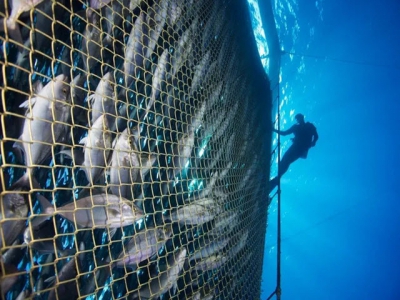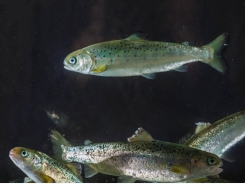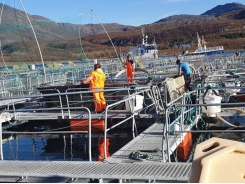10 reasons to be cheerful about aquaculture in 2021

Aquaculture operators can be largely optimistic about their prospects in 2021, although some farmers, particularly in Chile, may struggle to fulfil increasingly onerous regulations.
Innovasea believes that open ocean aquaculture will "make strides in the US and beyond" in 2021. Photo: Innovasea
So predict key figures from Innovasea, who released a list of predictions for 2021 today.
“Long-term trends in the aquaculture industry are still positive but there is some lingering near-term uncertainly because of Covid-19’s impacts on hotels and restaurants,” said David Kelly, CEO of Innovasea. “Fortunately, there has been an increase in home consumption of seafood, so that’s helped soften the blow from the pandemic.
“From a North American perspective, there’s a lot of interest in land-based aquaculture and the United States is now looking at ways to increase ocean-based aquaculture, which are both welcome developments.”
Other predictions from Innovsea staff:
New government regulations will prove challenging to fish farms in Chile
“Fish farms in Chile will be under immense pressure to comply with new government regulations that require them to do real-time monitoring of dissolved oxygen, salinity and temperature in and around their fish pens – and then transmit that data immediately to government agencies. There’s going to be steep learning curve for workers, and managers will need to put more thought and planning into their operations,” predicted Juan Pablo Barrales, the company's managing director in Chile.
Concerns about food security create opportunity for aquaculture
“2020 demonstrated that food security needs to be a national priority. With seafood dependence at an all-time high and wild catch fish stocks under stress, we see a prime opportunity for private entities, government and non-governmental organizations to work collaboratively to move forward various US-based aquaculture projects that have been in the works. This will help demonstrate not only the value of aquaculture, but how much operating procedures and technologies have evolved to meet current environmental standards and sustainability goals,” according to Rafael Cordero, vice president of engineering.
Open ocean aquaculture continues to grow, especially in warmer climates
“Open ocean aquaculture will take a major leap forward to meet the increasing demand for seafood due to its ability to produce significant volumes without interfering with other ocean activities like shipping and tourism. Moreover, the seafood industry is starting to see the benefits of fish farming in warmer climates – including faster growth rates and the ability to stock fish year round – despite more turbulent conditions and frequent storms. That’s because submersible aquaculture, an evolving form of fish farming over the past 30 years, has proven itself in rough waters and is now demonstrating its financial viability,” forecasts Langley Gace, senior vice president of open ocean aquaculture.
Companies will aim to reconnect with employees
“After a disruptive 2020, companies will be seeking ways to reconnect employees with one another, with leadership teams and with their business visions. Although the ways in which we interact with each other and the marketplace at large may have changed, our individual and organisational need to communicate and connect remains. 2020 created a vacuum of human connection that successful organizations will figure out how to fill in 2021,” says Mark Jollymore, president.
More fish farms will be situated onshore or further offshore
“In 2021 we will see a noticeable shift in where farmed fish are produced, with established near-shore farmers joining new entrants in moving both onshore and further offshore. Why? Because attractive near-shore sites are hard to find, user conflicts continue to grow, there are more factors that can influence fish health, and environmental concerns – whether founded or not – continue to dog the industry. At the same time, the technology for production on land or offshore in harsh environments has advanced and reached favorable price points for consideration. Bottom line is that both open ocean and land-based aquaculture are now considered more sustainable pathways for growth,” said George Nardi, vice-president of aquaculture services.
The US will finally embrace open ocean aquaculture and OK the first farms in federal waters
“2021 will mark the start of a new era in U.S. seafood production with the AQUAA Act picking up bipartisan support in Congress and gaining momentum. In addition, the National Oceanic and Atmospheric Administration and its supporting agencies will continue to demonstrate a clear, environmentally conscious permitting framework and issue its first set of permits for finfish production in federal waters in the Gulf of Mexico, the Atlantic and the Pacific,” according to Felipe Ramirez, business development manager.
Remote work will fuel improvements in fish farm monitoring and communications
“As upper-level employees embrace the work-from-home lifestyle, fish farm operators will have to look for better ways to manage their farms and mitigate risk. A combination of market pressures and technological advances will lead to better data streams and improved communications on farms. That will give managers better insight into their operations than ever before with real-time environmental data, feed rates and live pen videos available to them 24/7 from anywhere in the world,” noted Tyler Sclodnick, senior scientist.
Seafood consumption will skyrocket as the pandemic eases
“Once we have a working vaccine for Covid-19 in place, the international market for seafood will stabilise. Seafood producers have found new ways of getting their products to the people in this challenging time, and the industry has also focused on the value and importance of sustainable and healthy food. So I expect there will be higher consumption of seafood after the pandemic stabilizes and restaurants open up again. In the aquaculture industry, there is a major focus on innovation and taking advantage of new technology, so I see a bright future for fish farms and the developers of this new technology,” Tor Espen Skoglund, managing director, Norway.
Aquaculture will play a significant role in the post-pandemic world
“The seafood industry will play a key role in the post-pandemic recovery. As hotels, restaurants and other food services come back online, demand for fresh salmon will surge worldwide. With the retail market also growing, this could drive the price of salmon to an all-time high in Q2 or Q3. And as we get past the pandemic in late 2021, food security will become a front-burner issue. Countries will start to examine how they could survive another long-term disruption in the food supply. This will play favourably into the aquaculture industry. Countries with little or no aquaculture will start looking for new ways to develop this safe, sustainable industry locally,” thinks Tim Stone, vice president of product development.
Related news
Tools

Phối trộn thức ăn chăn nuôi

Pha dung dịch thủy canh

Định mức cho tôm ăn

Phối trộn phân bón NPK

Xác định tỷ lệ tôm sống

Chuyển đổi đơn vị phân bón

Xác định công suất sục khí

Chuyển đổi đơn vị tôm

Tính diện tích nhà kính

Tính thể tích ao




 Umitron launches automatic fish measuring system
Umitron launches automatic fish measuring system  How breeding can improve lice-eating efficacy of lumpfish…
How breeding can improve lice-eating efficacy of lumpfish…